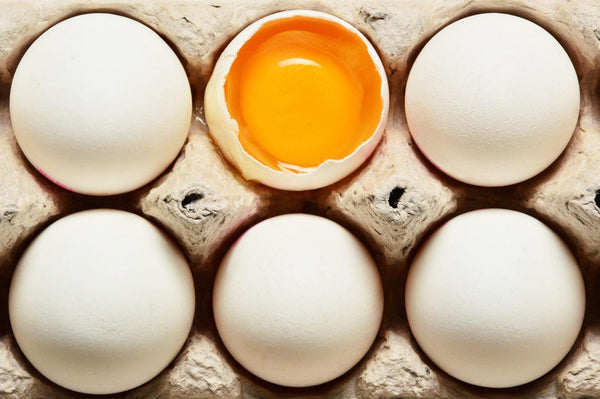
Jump to:
Although once vilified as a cause of arteriosclerosis, scientific understanding of the role of dietary cholesterol has changed over the last several decades, and most nutritionists agree that not only do eggs include a host of health-giving elements, but also that the high level of satiety they provide can help you lose weight.
But are all eggs equal? To paraphrase George Orwell’s “Animal Farm”, all eggs are equal, but some are more equal than others. In this blog post, we will take a deep dive into the world of Japanese eggs, pinpointing the differences between Japanese eggs and those in other countries, consider reasons for the strong orange color of their yolk, examine why they are “clean” enough to eat raw by looking at the egg production process and standards in Japan, and explore whether there is any significant difference between brown and white eggs.
We shall then discuss whether it is possible to purchase Japanese eggs outside of Japan, and what you can do to gain similar benefits in case it is not. We shall then round up by examining how Japanese people enjoy eggs in their diet and give some recipe ideas.
Japanese Vs Non-Japanese Eggs

There are three main differences between eggs in Japan and those in other countries. The first is the color of the yolk. Japanese egg yolks tend to be of a more vibrant orange color compared to those in America, for example, which are of a more yellow color. The reason for this will be explained later.
Another difference is the method of production and hygiene standards. It is a presumption when producing eggs in Japan that the egg will be eaten raw (although many are not), and the approach taken guarantees that doing so is safe. Such stringent requirements are not necessary in countries where it is assumed that all eggs will be cooked well before being consumed. Again, more detail will be given below.
The third difference concerns the expiry date or shelf life. This also relates to the presumption in Japan that the egg will be eaten raw, and is set to two weeks, whereas in America, this will be around one month in many cases.
Why Are Japanese Eggs So Orange?

As previously mentioned, the yolk of Japanese eggs is a different color from those found outside Japan. Basically, the color of the yolk is largely determined by what is fed to the hen. In America, eggs have lemon-colored yolks because the hens are fed yellow-colored feed, such as wheat or corn. In Japan, eggs are traditionally eaten raw as a topping for rice with a splash of soy sauce (a dish called Tamago-Kake-Gohan), and it was considered aesthetically pleasing for the yolk to have a deep orange color to contrast with the white color of the rice. Red paprika powder was added to the feed, and this produced the orange color. It is no indicator of higher quality, and is simply for appearance’s sake.
Is It Really Safe To Eat Eggs Raw In Japan?

Many people, when first visiting Japan, balk at the idea of eating raw eggs. One reason for this is an aversion to the texture of a raw egg, resulting from unfamiliarity. The main reason, however, is a deep-seated concern about hygiene. Several countries, including the U.K. have had outbreaks of salmonella disease over the last few years related to imported eggs and poultry. For this reason, the tendency in other countries is for eggs to be cooked thoroughly.
In Japan, however, the presumption is that eggs will be eaten raw, and the Japanese Ministry of Agriculture, Forestry, and Fisheries (MAFF) and the Ministry of Health, Labor, and Welfare (MHLW) have drawn up extensive guidelines on the proper handling of eggs, which are strictly enforced on farms and supply-chain workers. Eggs that do not meet the standards are either not sold or are labeled “not for raw consumption.”
There are two main risk points for salmonella disease: on-shell and in-shell. The guidelines include sterilizing the eggs while they are in their shells, and this eliminates the former risk. Japanese farmers address the latter risk of in-shell infection by making sure that their chickens are infection-free. These measures appear to be effective, and studies have shown that the incidence of in-shell infection is lower than 0.003%.
Additionally, as previously discussed, the shelf life of Japanese eggs is kept to two weeks, which means that, even in the extremely rare cases of infection, the bacteria is not allowed to proliferate to dangerous levels. This is another reason why Japanese egg producers largely keep hens in cages, in contrast to farms in foreign countries where free-range farming is more common. If the hen is in a cage, it makes it easier to know exactly when an egg is laid, whereas eggs can get hidden if the hens are wandering around a larger area.
Are Brown Eggs Different From White Eggs?

Depending on where you buy your eggs, brown eggs may be more expensive for the same-sized egg compared to white eggs. From this, you may be excused for believing that brown eggs are somehow superior to white eggs, either in taste or nutrition, but this is not necessarily the case.
The only difference between brown and white eggs laid by healthy chickens is the type of hen. White egg-laying hens are represented by breeds such as White Leghorns, while brown egg-laying hens are represented by breeds such as Rhode Island Reds. Interestingly, the color of the eggshell is genetically determined to be the same color as the chicken’s earlobe. Brown egg-laying hens secrete a pigment called protoporphyrin and lay reddish color eggs. White egg-laying hens, however, lack this pigment, and the eggs come out white as a result. Not only are the taste and nutrients of brown and white eggs the same, but the thickness of the shell is the same too. Differences in shell thickness depend on the age of the hen. Eggs from young hens generally have harder shells than eggs from older hens, and this is true for both white and brown egg-laying hens.
There is a theory that white eggs break more easily than brown eggs, but the real reason for the difference in price between the two is that brown eggs somehow look healthier. Don’t be fooled. It’s just marketing!
Eating Raw Eggs Outside Japan
Japan exports eggs, with the vast majority (approximately 90%) going to Hong Kong, which is also very partial to raw eggs. But what about if you live in a country to which Japan does not export eggs? Does that mean you can never eat raw eggs?
Fortunately, this is not the case. If you wish to eat raw eggs, though, you should definitely pasteurize them first. The art of pasteurizing raw eggs is to heat them to a temperature that is hot enough to sterilize them but not hot enough to cook the egg.
Unless you have a pasteurizing machine, in which case pasteurizing eggs will be extremely simple, you can use a thermometer inside the pan to make sure the water stays at the correct temperature.
The procedure is as follows:
(1) Put the eggs (in their shells) in a saucepan with enough water to cover the eggs by 2-3 cm.
(2) Place over a medium heat and bring the water to a heat of approximately 60℃.
(3) If the temperature starts to climb above 60℃, add cold water to cool it down.
(4) Keep at around 60℃ for approximately three minutes (or in case of large eggs, between four and five minutes).
(5) Drain away the water.
(6) Cool the eggs under cold running water or with ice.
(7) Dry with a towel
The eggs are now ready to be eaten raw or used for making things like mayonnaise or thousand-island dressing.
How Do Japanese People Enjoy Eggs?

Japan is said to be the second largest consumer of eggs per capita in the world, and eggs are enjoyed in a multitude of ways, both raw and cooked. We have an entire article outlining Japanese egg recipes, but a few examples are given below.
Japanese Dishes Using Raw Eggs
As mentioned above, a signature Japanese dish using raw eggs is Tamago-Kake-Gohan, in which raw egg is poured over a steaming bowl of rice, which, in turn, slightly cooks the egg. The egg is usually flavored with soy sauce and/or chili powder, but you might also like to try this Teraoka Sweet Soy Sauce for egg dishes, which combines soy sauce with bonito flakes, Kombu, and oyster extract.
Another popular dish that uses raw eggs is Sukiyaki, where it is used as a dip for the meat from the pot. Here, you can find recipes for making both Kanto-style and Kansai-style Sukiyaki at home.
Then, there is Tsukimi Udon. Tsukimi literally means “moon viewing”, and consists of a bowl of thick wheat noodles and a raw or poached egg, where the round egg represents the moon. It is traditionally eaten during the “moon viewing festival” on August 15th.
The Gyudon beef bowl restaurants, such as Yoshinoya or Matsuya will also give you the option of pouring a raw egg over your beef bowl.
Japanese Dishes Using Cooked Eggs
Representative dishes using cooked eggs include Chawan-Mushi, which can be described as a savory steamed egg custard dish, often containing Shiitake mushroom and boiled shrimp, and eaten with a spoon.
There is also Tamagoyaki, which is a kind of sweet rolled omelet. If you prefer a non-sweetened version of this dish, then you should ask for Dashimaki-Tamago, where the eggs are mixed with soup stock.
A popular dish at coffee shops and family-oriented restaurants is Omurice, which consists of fried rice wrapped in an egg omelet and topped with tomato ketchup.
Last, but by no means least, is Oyakodon (literally “parent and child over rice”). The reason for the name will become apparent when you learn that the main ingredients, other than the rice, are chicken and egg.
You can find recipes to the above and others here, so why not try making them at home?
If you are an egg lover, you will also find this microwave egg cooker from Akebono a quick and easy way to boil eggs without constantly needing to be watching the pot.
Egg-ceptional Eggs From Japan (Sorry!)
A number of factors set Japanese eggs apart from non-Japanese eggs including the color of their yolk, their strict production standards, and expiry dates. The latter two factors in particular have created an environment in which the consumption of raw eggs is not only accepted but makes up a vital part of the culinary culture.
Are you an egg lover? If so, what are your favorite dishes using raw and/or cooked eggs? Let us know in the comments.


0 comments